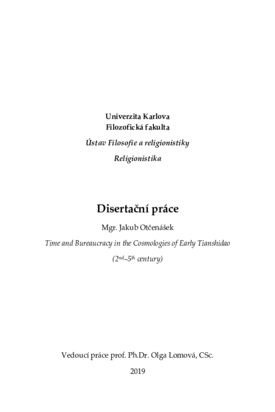Time and Bureaucracy in the Cosmologies of Early Tianshidao (2nd-5th century)
Čas a byrokracie v kosmologiích rané Tianshidao (2.-5. století)
dizertační práce (OBHÁJENO)

Zobrazit/
Trvalý odkaz
http://hdl.handle.net/20.500.11956/111352Identifikátory
SIS: 146828
Kolekce
- Kvalifikační práce [24991]
Autor
Vedoucí práce
Oponent práce
Vávra, Dušan
Assandri, Friederike
Fakulta / součást
Filozofická fakulta
Obor
Religionistika
Katedra / ústav / klinika
Ústav filosofie a religionistiky
Datum obhajoby
27. 9. 2019
Nakladatel
Univerzita Karlova, Filozofická fakultaJazyk
Angličtina
Známka
Prospěl/a
Klíčová slova (česky)
Tianshidao|taoismus|raně středověká Čína|kosmologie|milenialismusKlíčová slova (anglicky)
Tianshidao|Daoism|Early-Medieval China|cosmology|millennialismse zaměřuje na náboženské hnutí Tianshidao (Cesta nebeských mistrů) ve druhém až pátém století n.l. Tianshidao je představeno jako mnohotvárná tradice, která by neměla být redukována předem definovanou esence či teleologickým chápáním dějin. Autor se nepokouší o rekonstrukci její kosmologie v celku, ale interpretuje jednotlivé texty jako představitele různých kosmologií. Srovnává je na základě teorie (známá též jako "teorie kultur") Marry Douglas pomocí ukazatelů ("mřížka") a ("skupina"). Zvláštní pozornost upírá na používání byrokratických představ reprezentací času minulosti, přičemž rozlišuje různé typy mileanialismu. Klíčová slova Tianshidao, taoismus, raně středověká Čína, kosmologie, milenialismus
The dissertation focuses on the texts of a religious movement known as Tianshidao (the Way of the Celestial Masters) from the 2nd to the 5th century CE. Tianshidao is presented as a multifaceted tradition that should not be reduced by a predefned essence or a teleological vision of history. Instead of reconstructing one coherent cosmology, the author interprets the texts as representing various alternative cosmologies. They are compared according to the theory of cultural bias of Mary Douglas, in terms of grid and group. Special atention is paid to the employment of the bureaucratic imagery and the representations of time which are interpreted in the context of the cultural bias and the various modes of relationship towards the institutions of Tianshidao and the state. The author also analyses the millennialist character of the movement which was noted by previous research and distinguishes between various types of millennialism. Key words Tianshidao, Daoism, Early-Medieval China, cosmology, millennialism.
